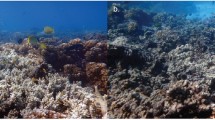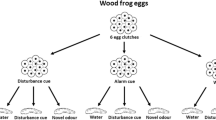Abstract
Aquatic prey can gauge predation risk using chemical information, including chemical alarm cues — released when prey are injured, disturbance cues — released when prey are threatened, or the odour of the predator itself. While a lot of work has focused on alarm cues, disturbance cues remained poorly studied in freshwater systems, and has been virtually omitted in marine ones. In the current study, we document the first evidence of disturbance cue use in a marine fish. Juvenile damselfish Pomacentrus nagasakiensis were exposed to cues from undisturbed or disturbed conspecifics, a water control (negative control) and conspecific alarm cues (positive control). Juveniles displayed increased antipredator responses when exposed to alarm cues and disturbed conspecifics, but not when exposed to undisturbed ones. In addition, we demonstrated that disturbance cues, just like alarm cues, could mediate learned predator recognition, a phenomenon undemonstrated in freshwater fishes. Given disturbance cues are thought to be comprised of nitrogenous waste, it has been hypothesised that the constant and dilute release of such products in the hypotonic freshwater environment results in a high level of ‘background chemical’ noise masking subsequent releases. Extending this hypothesis, we propose that in the marine environment, disturbance cues are more easily detected due to low background noise.
Significance statement
Prey animals must accurately assess their current predation risk. Aquatic prey rely on chemical cues to gain information on risk. These cues can include odours released when nearby prey are damaged or disturbed, or the odour of a known predator. Prey exposed to a novel odour for the first time must learn if the odour is an indication of risk or benign. This is accomplished when the odour of a known risk (e.g. cues released from a damaged individual) is paired with a novel odour (e.g. a novel predator). In the current paper, we show for the first time that coral reef fishes can use disturbance cues (cues released when prey are chased or otherwise disturbed) as a ‘known risk’ and when paired with a novel odour, are subsequently able to respond to the novel odour when presented alone.


Similar content being viewed by others
Data availability
The datasets generated during and/or analysed during the current study are not publicly available but are uploaded as supplementary material.
References
Bairos-Novak KR, Mitchell MD, Crane AL, Chivers DP, Ferrari MCO (2017) Trust thy neighbour in times of trouble: background risk alters how tadpoles release and respond to disturbance cues. Proc R Soc B 284:20171465
Bairos-Novak KR, Ferrari MCO, Chivers DP (2019) A novel alarm signal in aquatic prey: familiar minnows coordinate group defences against predators through chemical disturbance cues. J Anim Ecol 88:1281–1290
Beauchamp G (2019) On how risk and group size interact to influence vigilance. Biol Rev 94:1918–1934
Bett NN, Hinch SG, Yun SS (2016) Behavioural responses of Pacific salmon to chemical disturbance cues during the spawning migration. Behav Process 132:76–84
Brown GE, Smith RJF (1998) Acquired predator recognition in juvenile rainbow trout (Oncorhynchus mykiss): conditioning hatchery-reared fish to recognize chemical cues of a predator. Can J Fish Aquat Sci 55:611–617
Brown GE, Jackson CD, Malka PH, Jacques E, Couturier MA (2012) Disturbance cues in freshwater prey fishes: does urea function as an ‘early warning cue’ in juvenile convict cichlids and rainbow trout? Curr Zool 58:250–259
Brown GE, Ferrari MCO, Elvidge CK, Ramnarine I, Chivers DP (2013) Phenotypically plastic neophobia: a response to variable predation risk. Proc R Soc B 280:20122712
Chivers DP, Smith RJF (1998) Chemical alarm signalling in aquatic predator-prey systems: a review and prospectus. Ecoscience 5:338–352
Chivers DP, Wisenden BD, Smith RJF (1996) Damselfly larvae learn to recognize predators from chemical cues in the predator’s diet. Anim Behav 52:315–320
Chivers DP, McCormick MI, Mitchell MD, Ramasamy RA, Ferrari MCO (2014) Background level of risk determines how prey categorize predators and non-predators. Proc R Soc B 281:20140355
Chivers DP, Brown GE, Ferrari MCO (2012) The evolution of alarm substances and disturbance cues in aquatic animals. Chemical Ecology of Aquatic Systems, 1st edn. Oxford University Press, Oxford
Ferrari MCO, Chivers DP (2010) The ghost of predation future: threat-sensitive and temporal assessment of risk by embryonic woodfrogs. Behav Ecol Sociobiol 64:549–555
Ferrari MCO, Trowell JJ, Brown GE, Chivers DP (2005) The role of learning in the development of threat-sensitive predator avoidance by fathead minnows. Anim Behav 70:777–784
Ferrari MCO, Vavrek MA, Elvidge CK, Fridman B, Chivers DP, Brown GE (2008) Sensory complementation and the acquisition of predator recognition by salmonid fishes. Behav Ecol Sociobiol 63:113–121
Ferrari MCO, Wisenden BD, Chivers DP (2010) Chemical ecology of predator-prey interactions in aquatic ecosystems: a review and prospectus. Can J Zool 88:698–724
Ferrari M, McCormick M, Allan B, Chivers D (2017) Not equal in the face of habitat change: closely related fishes differ in their ability to use predation-related information in degraded coral. Proc R Soc B 284(2016):2758
Gonzalo A, Lopez P, Martin J (2010) Risk level of chemical cues determines retention of recognition of new predators in Iberian green frog tadpoles. Behav Ecol Sociobiol 64:1117–1123
Herzog Q, Rabus M, Wolfschoon Ribeiro B, Laforsch C (2016) Inducible defenses with a “twist”: Daphnia barbata abandons bilateral symmetry in response to an ancient predator. PLoS ONE 11:e0148556
Hettena AM, Munoz N, Blumstein DT (2014) Prey responses to predator’s sounds: a review and empirical study. Ethology 120:427–452
Kiesecker JM, Chivers DP, Marco A, Quilchano C, Anderson MT, Blaustein AR (1999) Identification of a disturbance signal in larval red-legged frogs, Rana aurora. Anim Behav 57:1295–1300
Lima SL, Dill LM (1990) Behavioral decisions made uder the risk of predation - a review and proposectus. Can J Zool 68:619–640
Lonnstedt OM, McCormick MI, Meekan MG, Ferrari MCO, Chivers DP (2012) Learn and live: predator experience and feeding history determines prey behaviour and survival. Proc R Soc Lond B 279:2091–2098
Magurran AE (1989) Acquired recognition of predator odor in the Europeon minnow (Phoxinus phoxinus). Ethology 82:216–223
Manassa RP, McCormick MI, Chivers DP, Ferrari MCO (2013a) Social learning of predators in the dark: understanding the role of visual, chemical and mechanical information. Proc R Soc B 280:20130720
Meekan M, Wilson SG, Halford A, Retzel A (2001) A comparison of catches of fishes and invertebrates by two light trap designs, in tropical NW Australia. Mar Biol 139:373–381
Mirza RS, Chivers DP (2002) Behavioural responses to conspecific disturbance chemicals enhance survival of juvenile brook charr, Salvelinus fontinalis, during encounters with predators. Behaviour 139:1099–1110
Sheriff MJ, Peacor SD, Hawlena D, Thaker M (2020) Non-consumptive predator effects on prey population size: a dearth of evidence. J Anim Ecol 89:1302–1316
Tariel J, Plenet S, Luquet E (2020) Transgenerational plasticity of inducible defences: combined effects of grand-parental, parental and current environments. Ecol Evol 10:2367–2376
Vavrek MA, Brown GE (2009) Threat-sensitive responses to disturbance cues in juvenile convict cichlids and rainbow trout. Ann Zool Fenn 46:171–180
Vavrek MA, Elvidge CK, DeCaire R, Belland B, Jackson CD, Brown GE (2008) Disturbance cues in freshwater prey fishes: do juvenile convict cichlids and rainbow trout respond to ammonium as an ‘early warning’ signal? Chemoecology 18:255–261
Wisenden BD (2019) Evidence for incipient alarm signalling in fish. J Anim Ecol 88:1278–1280
Acknowledgements
We thank the Lizard Island Research Station staff and our volunteers. Additionally, we thank the reviewers for improving the quality of the manuscript.
Funding
Research funds were provided by the Australian Research Council Centre of Excellence for Coral Reef Studies (EI140100117; MIM), an Australian Research Council Discovery Grant (DP 170103372; MIM, MCOF, DPC), and NSERC funding (MCOF, DPC).
Author information
Authors and Affiliations
Corresponding author
Ethics declarations
Ethical statement
All research was conducted in accordance with the James Cook University (JCU) Animal Ethics guidelines with approval from the JCU Animal Ethics Committee (approval A2408).
Consent for publication
All authors are aware of the submission in its current form.
Conflict of interest
The authors declare no competing interests.
Additional information
Communicated by J. G. Frommen.
Publisher's note
Springer Nature remains neutral with regard to jurisdictional claims in published maps and institutional affiliations.
Supplementary Information
Below is the link to the electronic supplementary material.
Rights and permissions
About this article
Cite this article
Pollock, M.S., Hoyle, Z., Mccormick, M.I. et al. Disturbance cues facilitate associative learning of predators in a coral reef fish. Behav Ecol Sociobiol 75, 149 (2021). https://doi.org/10.1007/s00265-021-03088-z
Received:
Revised:
Accepted:
Published:
DOI: https://doi.org/10.1007/s00265-021-03088-z




